Chancellor's Fellow Wolz Hopes to Revolutionize Agriculture Via
Woody Perennial Polyculture
September 6, 2013
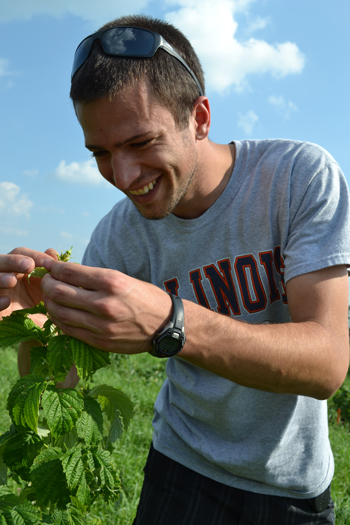
Kevin Wolz examines a plant at the Woody Perennial Polyculture Research plot.
Around 150 guests, including some local farmers, who visited the Woody Perennial Polyculture Research (WPPR) site on Thursday, September 5th, did more than tour the gardens, taste the raspberries, and sample the "home-grown" food. As part of the WPPR Field Day, Kevin Wolz's Chancellor's Public Engagement project, visitors to the South Lincoln plots learned about his system, which he is proposing as an alternative to corn and soybeans.
This is what the farmers experienced: row after row of chestnut trees, hazelnut, or apple trees, under-planted with not only red, but gold "Anne" raspberries, currants, and some grape vines. In between the rows were swaths of pasture on which animals could peacefully graze.
The goal of the Field Day was to engage the farmers and give them specific information on how to actually implement this on their own farms. Wolz hopes the farmers would, "not just come away with, 'Oh, that was cool,' but, 'Wow! I want to get involved with U of I and do this.'"
Wolz, a graduate student in the Institute for Genomic Biology and a member of the DeLucia Lab, didn't just wake up one morning thinking, "I want to introduce a new kind of agriculture to the American Midwest." He got his undergraduate degree in biology and environmental engineering, specifically the restoration of natural eco-systems. While he considered spending his time restoring degraded forests or prairies to make them fully functioning—a Herculean task because, according to Wolz, "Most of Illinois is bare black earth half of the year"—he encountered another dilemma, both humanitarian and economic: "If you go across Illinois and try to restore all of that, you're not going to have any food being produced."
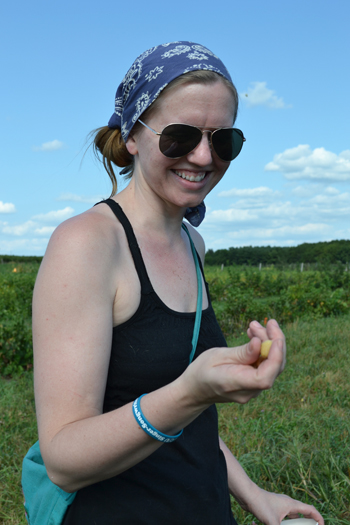
Invited to "graze," Jeni Hobler, a visitor to WPPR's Field Day prepares to taste the gold raspberries.
This led him down the path of meeting people and reading books, until he arrived at his philosophy—a question he hopes that initially, the WPPR project, then eventually, a whole lot of Midwestern farmers, will help him answer:
"Can we take an acre of land and put crops on it in such a way that it is performing the ecosystem services that we want, such as sequestering carbon or biodiversity, but also producing comparable calories per acre—food that people can eat? So that's what we're doing here—both restoration and agriculture at the same time."
Wolz says Woody Perennial Polyculture mimics the system that used to be here: Midwestern Oak Savannah: grass underneath, shrubs scattered around, then a canopy of oak trees scattered even farther. However, WPP uses specific similar species that produce crops. He didn't randomly arrive at the selection of the species or their arrangement in his system; both were based on research and what has worked for real-world farmers.
For example, he included currants in his system because of their culture. "They're awesome in this system, because they actually grow better in the shade. Instead of having the typical chestnut orchard, where you have chestnut trees spaced out with bare black earth underneath, you can grow currants underneath, with no extra land use, but you're getting extra revenue off of that." Most Americans are not very familiar with currants, but they are evidently big in Europe. Wolz explains to people who ask about them, "When you [an American] eat a raspberry or a blueberry, a European eats a currant."
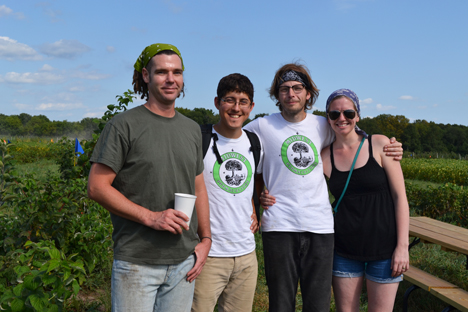
Representatives from Midwest Permaculture, a similar agricultural project inStelle, Illinois, made the trip down to campus to participate in the field day.
In addition to Wolz, the WPPR team includes three students who help with maintenance and harvest, a larger group of students who help harvest bumper crops of ripe berries, and three or four professors who act as advisors. Via a grant from the Student Sustainability Committee last fall, the WPPR site partners with Dining Services to place fresh, organic produce onto the tables in the university dining halls.
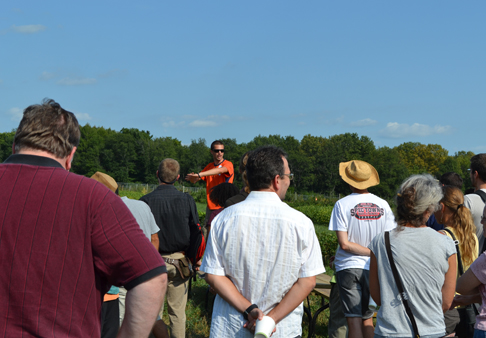
Kevin Wolz presents his WPPR system to visitors during WPPR's Field Day.
Hoping to increase the scope of the project's impact beyond the lucky Illinois students who got to feast on the 200 pints of raspberries and 100 of currants their project produced this past summer, Wolz recognized the importance of adding an education outreach component. So he submitted a proposal for the Chancellor's Public Engagement Grant to help the group communicate research about agriculture:
Wolz fully embraces Illinois' mandate: "Because this is a land-grant university that's supposed to be sharing our ag knowledge with all kinds of farmers across the Midwest, we thought that was a really important thing to include as well, to get farmers out here and see this, and then see if we can help them do this in the real world."

Jess Mulcrone, WPPR site manager, enjoys raspberries during the Field Day.
WPPR held a pilot field day in the spring 2013 for about 20 people: farmers, professors, and community members. Wolz reports that some of the farmers who came initially "now want to do this on their farms."
Jess Mulcrone, the WPPR site manager, estimated that about 150 people showed up. Mulcrone, who also attended the pilot field day in the spring, which was a lot smaller, and wasn't as nice a day, felt the main event went well. "I think it's great. This is nice to have it delightful and sunny, and have everyone see how pretty it is. There's so many people, and the food is good. And people seem excited. I'm glad to see so many people going on the tour and wanting to see what Kevin has to say."
Mulcrone received her Bachelor's degree in biology from Illinois in 2012. She and Wolz majored in Integrative Biology together. Involved in animal behavior research as an undergrad, she found Wolz's work intriguing. "Something about his research was very exciting to me, so I wanted to be involved and experience a different kind of research."
What did the WPPR team hope to achieve through the Field Day? Because the site is still in its infancy (the plants are only two years old), "It's really hard to show farmers what the system can be," explains Wolz, "because it's a long-term thing." So their goal was this:
"We really want to just get farmers here, and get them engaged with this project, and help them realize that the University of Illinois is doing more than just corn and soybeans."
His second goal was a bit more ambitious: to revolutionize agriculture in the Midwest: "The next level of where this system can go in the real world: we view this as the next industrial agriculture that can replace corn and soybeans, not as just something that you put in a few acres and just grow fruits and nuts."
People who challenge his system, argue: "Well, you just can't change the whole world and make them eat fruit and nuts all the time; our economy is geared to use corn and soybeans as fats, proteins, and carbs. We need those things."
Wolz's well-thought-out response? "Chestnuts are basically corn growing on trees. The nuts produced by chestnuts are mostly starch, just like corn. So we can take chestnuts and theoretically put them in the same hole in the same processing plant that corn goes into, and out the other end you can still get all your processed corn products, from paint to baby diapers to cow food to human food."
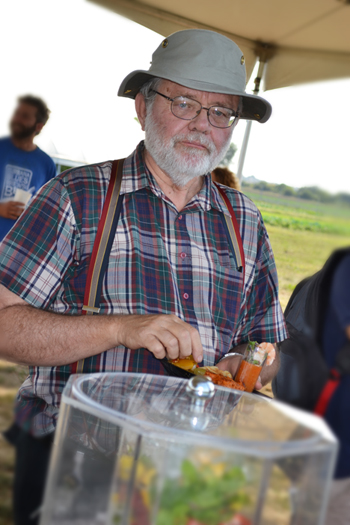
Illinois professor Bob Skirvin, who has a nearby research plot, enjoys a plate of food during the Field Day. Snacks at the event showcased the partnership between WPPR, the Student Sustainability Committe, and Dining Services, using mostly food grown on site, which was prepared by Dining Services.
Regarding hazelnuts, Wolz reiterates, "the same thing—soybeans on trees." Similar to soybeans, hazelnuts are 50% protein/50% oil. According to Wolz, processing plants could use them to make products similar to tofu and soy protein and "all that stuff—but it just happens to come from a tree and not an herbaceous plant."
Wolz adds that his system is feasible economically. It can potentially produce the same volume per acre, plus an added bonus that might be appealing not only to ecologists, but to farmers who tend to keep their eye on the bottom line: "Over time, your maintenance costs basically go to $0, because these trees can live for 300 years, and you only plant them one time, and once they're planted and established, you're done. Expenses go practically to $0 over time." Unlike with corn and soybeans, which require a huge outlay each year for seeds, chemicals, fuel, and equipment.
"So that's where the system can go in the future," sums up Wolz, "Those two crops as the core of the system, as potentially the next two commodity crops even, and everything else underneath is basically just fluff, but also helping provide those ecosystem services that then do the restoration side of things."
Story and photos by Elizabeth Innes, Communications Specialist, I-STEM Education Initiative.
More: Champaign-Urbana Community, Chancellor's Public Engagement Project, K-12 Outreach, Open House/Expo, 2013
For additional I-STEM stories about the 2013 Chancellor's Public Engagement fellows and their projects, see Danville School Experiences a "Night at the Museum" Courtesy of Illinois Researchers.
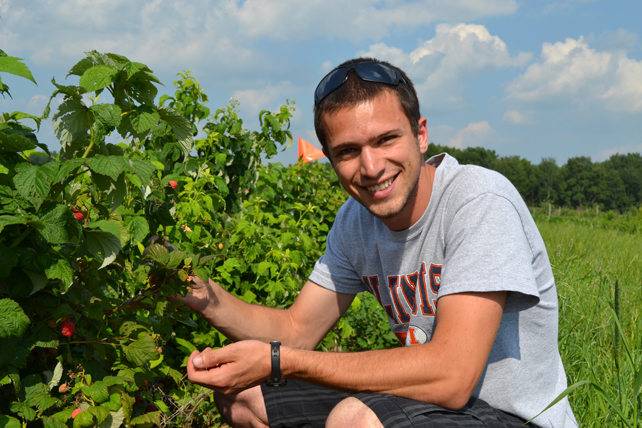
Kevin Wolz picks some berries from one of the WPPR site's two-year-old red raspberry plants.













.jpg)
















